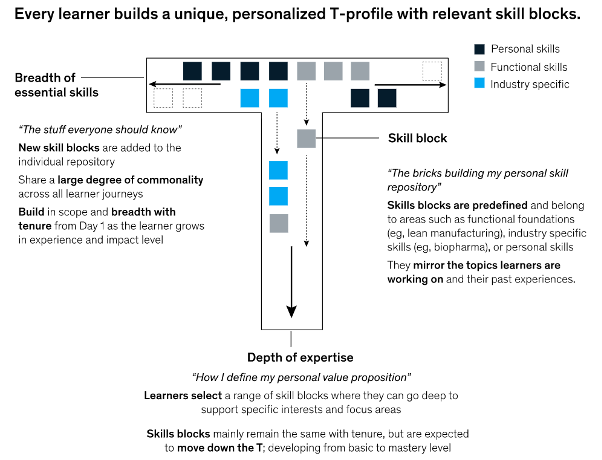
Deliberate practice is an effective strategy that can be employed to develop and improve skills through eLearning. This article outlines how L&D teams can implement deliberate practice when developing asynchronous training solutions.
Why Do Most Upskilling and Reskilling Initiatives Fail to Create the Desired Impact?
More companies are recognizing the advantage of upskilling employees versus hiring for new talent. However, skill requirements are evolving very rapidly. Not only does this mean that organizations should initially hire people who are flexible, adaptive, and know how to learn, but training efforts – either upskilling or reskilling – should be able to build tactical capabilities within employees that drives performance.
- Most training is information heavy but lacks direction and opportunity to apply and deliberate practice opportunities.
- Also, L&D teams tend to focus on basic metrics such as number of attendees, consumption, and reaction results instead of measuring the impact to business performance.
- But it doesn’t matter how much instruction takes place if employees are not given ample opportunity to practice what they learn in progressively higher stakes and realistic situations.
Learning should be designed for specific skills, leading with information acquisition but followed-up by deliberate practice. Deliberate practice, as much as possible, is most effective when coupled with robust feedback loops.
How Can Learners Build Expertise?
For most organizations, each employee should share a common set of core capabilities and skills, including things like innovation and creativity, communication and stakeholder management, and business and industry knowledge. Beyond a wide-ranging limited working knowledge of those shared competencies, the most effective employees identify specialized competencies and skills on which they should focus and deepen their expertise.
According to McKinsey & Company, this is referred to as a personalized T-profile of skills (see image below).

Source: McKinsey & Company
True depth of expertise is built as employees learn on the job, use deliberate practice with coaching and feedback, and finally have the opportunity to apply what they learn on the job.
How Do You Design Learning Programs to Drive Deliberate Practice and Improve the Application of Learning on the Job?
Learning that employs deliberate practice is founded on the following principles:
- Breaking down training programs into clearly defined specific skills. These should be concrete skills that can be explained, modeled, and practiced.
- Creating specific learning solutions that build the foundational knowledge of defined skills. This is the knowledge acquisition phase of learning.
- Adding deliberate practice of those skills, initially in low-risk situations where participants are safe to ask questions, experiment, fail, and try again. During these deliberate practice sessions, employees should receive honest and clear feedback from coaches or mentors to help drive progress and development.
How Do You Set Learners Up for Success when Using Deliberate Practice?
Deliberate practice is not always comfortable for learners. While they should feel safe to fail, practice should not be easy. In the words of the fictional European football coach Ted Lasso: “Taking on a challenge is a lot like riding a horse, isn’t it? If you’re comfortable while you’re doing it, you’re probably doing it wrong.”
L&D teams and leaders need to foster within learners a growth mindset instead of a fixed mindset. Learners with a growth mindset view things like challenges as opportunities to grow instead of something to avoid and feedback as an opportunity to learn instead of something to ignore. As Carol Dweck, an American psychologist, explains—it’s important for learners to consider the power of yet:
- “I don’t understand this yet, but I will soon.”
- “I can’t perform this operation yet, but I will after more practice.”
- “I’m not doing this perfectly every time yet, but after working on it some more I will.”
Along with a healthy growth mindset, L&D teams can help employees build lifelong learning habits by:
- Rewarding learning. Recognize those who put effort into learning new skills or deepening their knowledge of existing skills. Permit them to share what they’ve learned.
- Rewarding failure. Learners need the opportunity to apply what they’ve learned, fail, receive feedback and coaching, and then try again.
- Teaching people how to learn. This is a good exercise at the beginning of most formal learning solutions – cues to help learners sharpen their acquisition and application skills.
- Encouraging managers and executives to set an example of being learners by sharing what they’re learning and how they’ve applied those things.
- Promote employees who learn, apply what they learn, and take calculated risks instead of those who just stay on the job doing the same safe thing over and over again.
What eLearning Strategies Can Support Deliberate Practice
The following strategies have shown to be effective when supporting deliberate practice:
- Microlearning – Using short bursts of easily consumable content allows learners to acquire new information and skills on-the-job and in the flow of work.
- Gamification – Gamification is a great way to engage learners in non-threatening ways that helps them apply what they’ve learned and encourages them to come back to learning content as often as they need it.
- Simulation based learning – Using simulations is another way to give learners a low-stake opportunity to apply new information. Simulations are helpful, either done asynchronously or with live coaches and mentors, because learners can receive immediate feedback on their progress, reassess their approach, and then try again.
- Blended learning – Approaching learners from a number of modalities reinforces newly gained knowledge and creates opportunities for subject matter experts to give feedback during practice sessions.
- Social learning – One of the best ways to solidify knowledge is when it can be shared with others. Social learning allows participants to learn new information, apply it, assess their rate of success, and share lessons learned with others. This also promotes the effectiveness of training and encourages others to actively participate.
Parting Thoughts
Deliberate practice – practice that includes coaching, feedback, and iterative application of new knowledge – can greatly increase the upskilling and reskilling of employees. This article has highlighted strategies that training teams can use to build eLearning and include directed practice to decrease learner time to proficiency.
Want to learn how to prepare an effective L&D Strategy for 2022?
Download our latest eBook, ‘How to Conduct an L&D Audit and Prepare a Strategic Plan for the Future.’
Reference
Hammer, M., Harris, M., Ramnane, K., Blackwell, E., (2021, July 19). Ops 4.0—The Human Factor: A class size of 1. McKinsey & Company. Retrieved from https://www.mckinsey.com/business-functions/operations/our-insights/operations-blog/ops-40-the-human-factor-a-class-size-of-1



